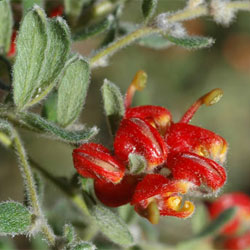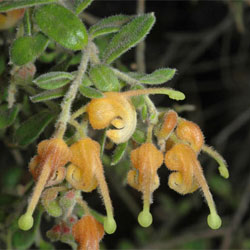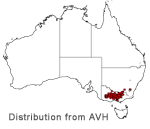Grevillea alpina
 |
 |
Alpine Grevillea, Cat's Claw Grevillea
Grevillea alpina commonly known as Mountain Grevillea, Cat’s Claw or Alpine Grevillea belongs to the Proteaceae family. Despite its name this species is not restricted to alpine areas and is rarely found there.
 Grevillea
alpina is a spreading shrub that varies greatly in height. Some forms are
prostrate while others grow up to two metres. The leaves take on a variety of
forms, varying in size from 0.5-3 cm long and 1.5-10 mm wide, are hairy or glabrous
and have margins that are incurved or recurved. The inflorescences are either
terminal or axillary and are simple to many-flowered.
Grevillea
alpina is a spreading shrub that varies greatly in height. Some forms are
prostrate while others grow up to two metres. The leaves take on a variety of
forms, varying in size from 0.5-3 cm long and 1.5-10 mm wide, are hairy or glabrous
and have margins that are incurved or recurved. The inflorescences are either
terminal or axillary and are simple to many-flowered.
Flowers are typically 1-3.5 cm long, can be a single colour, cream, green, yellow, orange, pink or dull red, or it can be a combination of these colours.
Grevillea alpina can be propagated both vegetatively and from seed. Cuttings should be taken from interseasonal growth (semi-hard material) flowering material should be avoided. A length between 5-10 cm should be used with half to a third of the leaves stripped off. A gel type plant hormone should be used. Cuttings are slow to grow, taking 6–8 weeks to strike.
Seed is the preferred method of propagation. Plants grown from seed have a stronger root system and also have a nicer growing shape, needing less pruning. For best results use fresh seed from the form that grows closest to your area. The seeds have an inhibitor that prevents germination immediately and this cannot be overcome by using treatments such as nicking, smoke water or peeling. Seeds should be soaked in room temperature water for 24 hours before sowing. Both cuttings and seeds should be sown in a coarse perlite mixture. The mixture needs to be well drained or basal rot can occur. Bottom heat should be used especially in the colder months.
This species is sensitive to excess water and excess nutrients. The watering regime differs after planting depending on the soil types; soils with better drainage can have more water. Watering should be reduced in summer, as the plant likes dry summers. Don’t use fertiliser in pots or in the garden, as this species is adapted to poorer soils.
When conditions are right this species can live for a long time, and with regular pruning will maintain a nice shape. Flowers are produced from July through to May if conditions are favourable. Flowers on all forms attract honey-eating birds. Grevillea alpina grows best in areas that have a dry summer, as it dislikes humidity. With the variability in both form and flower colours of Grevillea alpina, this species is a desirable horticultural plant.
Text by Tara Hopley (2004 Student Botanical Intern)
Derivation of the name: Grevillea alpinaGrevillea – Named after Charles Francis Greville (1749–1809), co-founder of London Horticultural Society, a patron of botany. alpina – derived from the Latin alpinus, meaning alpine in reference to the location from which the author of the name, John Lindley (1799-1865), believed it was first collected. |
References
Burke, D. (1983). Growing Grevilleas: Kangaroo Press.
Clarke, I., & Lee, H. (1987). Name That Flower: The Identification of Flowering Plants: Melbourne University Press.
Greig, D. (1999). Field guide to Australian wildflowers. New Holland Publishers (Australia) Pty Ltd.
Makinson, R. (2004). Personal Communication. 22nd January 2004.
McGillivray, D. J. (1993). Grevillea, Proteaceae: a taxonomic revision. Carlton, Victoria: Melbourne University Press.
Olde, P., & Marriott, N. (1995). The Grevillea Book. Volume 2. Kenthurst, New South Wales: Kangaroo Press Ltd.
Wrigley, J., & Fagg, M. (2002). Starting Out With Natives Easy-to-Grow Plants For Your Area: New Holland Publishers (Australia) Pty Ltd.
Harden, G.J. (ed) (2002). Flora of New South Wales. Revised Edition Volume 2. University of New South Wales Press Ltd.
Wilson, A.J.G.(ed) (2000) Flora of Australia. Volume 17A, Proteaceae 2, Grevillea. ABRS/CSIRO Australia.
![An Australian Government Initiative [logo]](/images/austgovt_brown_90px.gif)

